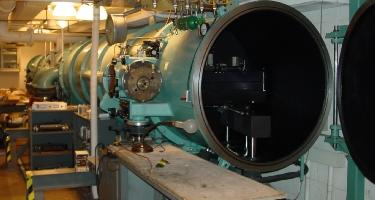Atomic Spectroscopy Group: Classical Spectroscopy
Each spectrograph in the Atomic Spectroscopy Group is among the most powerful of its type in the world. Collectively, the set of instruments available to our scientists and guest researchers is unparalleled in the world. Our spectrographs allow us to record spectra over a large range: from the extreme ultraviolet (1 nm) to the near infrared (1200 nm). We've collected spectra on hundreds of atomic systems over the years for data compilation and astronomical applications, as well as for more applied research in the lighting and microlithography fields.
Our instruments include:
10.7 m Normal Incidence Vacuum Spectragraph
Spectral Range: 30 nm to 500 nm
Plate Factor: 0.078 nm/mm (1st order)
Detection: Photographic or Scanning Photoelectric
10.7 m Eagle Spectrograph
Spectral Range: 200 nm to 1000 nm
Plate Factor: 0.078 nm/mm (1st order)
Detection: Photographic
10.7 m Grazing Incidence Vacuum Spectrograph
Spectral Range: 3 nm to 70 nm
Plate Factor: 0.012 nm/mm @ 7 nm (1st order)
Detection: Photographic
3.3 m High-resolution Plane-grating Spectrograph
Spectral Range: 190 to 1200 nm
Plate Factor: 0.013 to 0.11 nm/mm (order dependent)
Detection: Photographic
2.2 m Grazing Incidence Vacuum Spectrograph
Spectral Range: 1 nm to 60 nm
Plate Factor: 0.016 nm/mm @ 1 nm (1st order)
Detection: Photographic

Recent Projects:
- Precision measurement of F2 laser
We recently used our 10.7 m normal incidence vacuum spectrograph to make precision measurements of the wavelengths of lasing lines in a commercial molecular fluorine laser at 157 nm. - Spectra of highly-ionized atoms for fusion plasma diagnostics
As part of our continuing effort to provide spectroscopic data needed for diagnosis of controlled fusion plasmas we use our 10.7 m grazing incidence spectrograph to observe spectra of moderately- and highly-ionized atoms Spectra of Ar, Zr, Nb, Mo, and W are of particular importance due to their presence in the edge-plasma regions of tokamak machines. - Spectrum and energy levels of singly-ionized mercury (Hg II)
The spectra and energy levels of singly-ionized Hg was observed with out 10.7 m vacuum and air spectrographs. This spectra is of particular interest because it plays a prominent role in some chemically peculiar stars recently observed with the Hubble Space Telescope.
Contacts
-
(301) 975-3202

